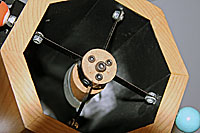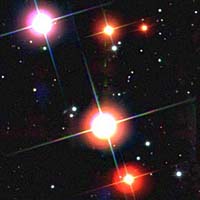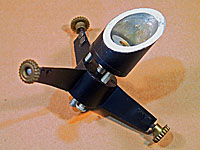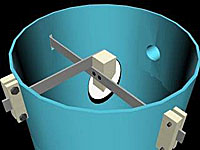

Spiders, Vanes & Stalks

This page will talk about many of the devices used to hold the diagonal, or secondary mirror, in the tube. The diagonal must held rigidly in the center of the tube directly under the focuser. It must also be able to be: (1) adjusted lengthwise along the optical axis of the telescope (to center it under the focuser); (2) adjusted rotationally along the optical axis of the telescope (to aim it directly along the optical axis of the focuser); and (3) adjusted for angle (tip) to precisely reflect the light cone 90° from the primary mirror into the focuser. Because anything in the optical path will cause diffraction and reduce the amount of light collected by the primary mirror, the diagonal support system needs to present the minimum possible optical obstruction while providing rigid support.
Diffraction

No doubt you have seen astronomical photographs where the bright stars have 'spikes' (usually four of them) radiating outwards: these are caused by diffraction effects (See Wikipedia article). Some people think these spikes enhance the appearance of the image, and some people think they degrade it. No matter which camp you are in, most everyone tries to minimize these effects - spreading light into your image is not generally a good thing. In order to minimize diffraction effects, we need to present the smallest possible obstruction to the optical path. Therefore, many diagonal holders use thin, wide metal vanes that are oriented edge-on to the optical axis of the telescope; any 'bulk' is either hidden behind the diagonal mirror or out of the optical path at the edge of the tube. Stalks have a harder time being thin - they need to be rigid in two axis and hence are often about 1/8 inch thick which is a 'fat' profile for a diagonal holder.
Because the spike pattern is mirror-imaged by the primary mirror, a single stalk will produce two spikes across a diameter. Four vane spiders produce eight spikes, but they are superimposed on one another and you see four. A three vane spider will produce six spikes. Curved vane holders produce diffraction effects also, but the light is spread out, and you do not perceive them. The diffraction is still present and does reduce the contrast of your image.
Stalks

Stalks are not very popular today; they saw a lot of use in the early years of telescope making. It is hard to make a stalk that is stiff and yet not thick in the optical path. They are however easy to make, simply a piece of about 1/8 diameter wire that is soft enough to bend for adjustments and stiff enough not to move once bent. At metal pad is attached to one end to glue the diagonal mirror to. Fine adjustments are difficult.
They most suited to small scope were their length is limited - as the stalk get longer it must be made thicker to retain stiffness. Also, most focusers today do not provide for stalk mounting, so a separate attachment to the tube must be fashioned.
Spiders

for a small tube
Spiders, with a thick, round 'body' and three or four spindly 'legs' are the most popular means of supporting a diagonal mirror today. Their hub, which holds a threaded rod, can be slightly tensioned to provided rigid support. At the end of the threaded rod, a diagonal holder must be attached, with provision for tip-tilt adjustments. The hub can be elongated along the optical axis of the telescope, and the spider vanes can be triangular, with wide bases attaching to the hug and pointy ends attaching to the tube for added stiffness without adding any additional blockage of the light path. The vanes can be made quite thin. Spiders with wires for vanes have also been built and used.
The diagonal holder can become a fancy machine shop project to compactly provide tip-tilt adjustment in the small space available. This can be done with wood (as shown on the first photo of this page) but requires the ability to do some precision drilling (a small table top drill press would be very helpful for this).
Curved vane spiders, with three or four vanes, are also used. While they spread out the diffraction so it is not perceived, they actually cause more diffraction because of the longer vane lengths.
Vanes
The term spider is usually applied to a symmetrical arrangement of thin, wide legs, while the vanes is applied to asymmetrical arrangements of thin, wide legs. A single leg that is round would be called a stalk, while a single leg that is thin and wide would called a vane, and would a two-vane support whose legs form a Vee. Vanes can be curved or straight. With vane type holders, as with stalks, you need to pay attention to stiffness and obstruction of the optical path.

Make or Buy?
There are plenty of varied and good spiders to purchase, but you can also make an excellent spider and diagonal holder that while simple to build works very well. We will show you how to build a Curved 2-Vane Diagonal Holder on the next page that very easy to build.
If don't like the idea of curved vanes, we would suggest you look at this straight vaned spider design on the ATMsite (mirror) by Nils Olof Carlin; it is quite straightforward and easy to build, and the adjustments are all outside the tube!
On the next page we build a diagonal holder and on the page after that we tell you how to install a diagonal holder, no matter what you have bought or build, into your tube.
Previous: The Diagonal
Mirror Next: Build a Curved Vane
Diagonal Holders
Back to the
Build a Dobsonian Master Index